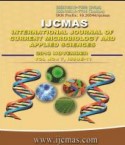


 National Academy of Agricultural Sciences (NAAS)
National Academy of Agricultural Sciences (NAAS)

|
PRINT ISSN : 2319-7692
Online ISSN : 2319-7706 Issues : 12 per year Publisher : Excellent Publishers Email : editorijcmas@gmail.com / submit@ijcmas.com Editor-in-chief: Dr.M.Prakash Index Copernicus ICV 2018: 95.39 NAAS RATING 2020: 5.38 |
Present study was designed to aim isolation and identification of halo blight bacterium; Pseudomonas syringae (savastoni) pv. phaseolicola (Psp) in seed lots of mung bean collected from fields of various districts of Rajasthan state, India. A heavy incidence of the pathogen was recorded in seed lots from Ajmer (82.5%) Nagaur (78.88%), Ganganagar (70%), Hanumangarh (76.34%) and Jalore (73.33%) districts. Total 33 isolates of Psp were isolated on semi selective medium MSP from the seeds of mungbean grown in Rajasthan state. These 33 isolates with typical morphological and biochemical characteristics of Psp were further examined through PCR amplification and sequencing of 16s rRNA gene. These isolates were characterized on the basis of colony characteristics, biochemical methods, pathogenicity test and further on the basis of 16s rRNA sequencing. The fragment of 16s rRNA gene of approximately 1.5kb size was obtained from these isolates and was amplified using universal primers; 8F and 1492R and identified as Pseudomonas syringae (savastoni) pv. phaseolicola when compared with database available on NCBI. A phylogenetic tree was constructed based on the 16s rRNA sequence using neighbour joining method (NCBI).
 |
 |
 |
 |
 |